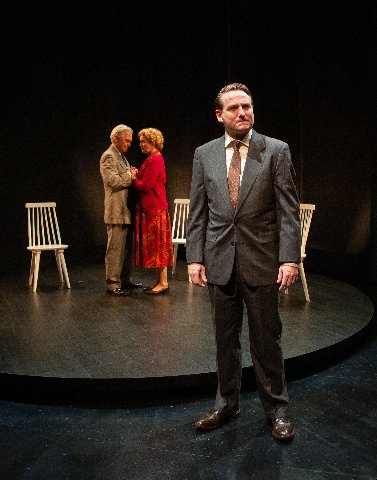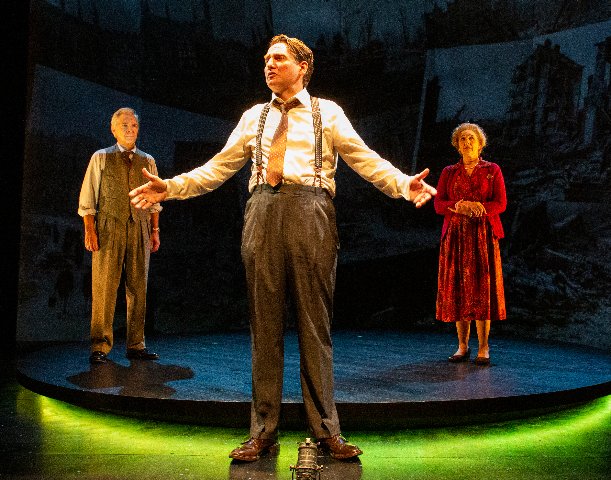Copenhagen Asks What If
Michael Frayn Play At Berkshire Theatre Group
By: Charles Giuliano - Oct 02, 2023
Copenhagen
By Michael Frayn
Directed by Eric Hill
Set, Randall Parsons; Costumes, Elivia Bovenzi Blitz; Lighting, Matthew A. Adelson; Sound, Scott Killian; Projections, Adam Lewis: Movement, Isadora Wolfe
Cast: David Adkins (Niels Bohr), Corinna May (Margrethe Bohr), Harry Smith (Werner Heisenberg)
Berkshire Theatre Group
Unicorn Stage
Stockbridge, Mass
September 28 to October 28
Michael Frayn’s heady and intense Copenhagen, at Berkshire Theatre Group, asks what if Adolph Hitler, had atomic bombs in his arsenal?
The answer to that question lay with Nobel Laureate, Werner Heisenberg (Harry Smith), who headed the potential nuclear program for Nazi Germany. Kept on a short leash by the Gestapo, he went to great effort to deliver a paper in occupied Copenhagen.
The real mandate of his difficult visit was to meet with mentor and friend, fellow Laureate, Niels Bohr (David Adkins), and his wife Margrethe (Corinna May).
Bohr won the Nobel Prize in Physics in 1922 for his work on the structure of atoms and the radiation emanating from them. He proposed a model for the hydrogen atom based on quantum theory and explained the emission of light quanta.
They had met when Bohr delivered a paper. Then just 21 the upstart Heisenberg upended the presentation by stating that his math was wrong. They later worked together, night and day, in Denmark for three years. That entailed walks that lasted for hours as they debated research and theory. Bohr was regarded as the Pope of theoretical atomic physics.
Heisenberg earned an appointment as department chair at the University of Leipzig. At 26 he was Germany’s youngest full professor. His many Jewish colleagues were purged by the Nazis and some made their way to the Los Alamos team of J. Robert Oppenheimer who developed America’s atomic bomb in an ostensible race with Heisenberg’s program.
In 1941 the colleagues and friends meet socially and went on one of their renowned strolls. Heisenberg wanted to speak privately as Bohr was likely bugged. Instead of the usual hours their conversation ended after a few minutes.
There is no documentation of what transpired. The speculation is that Heisenberg inquired what Bohr knew about American and British progress on developing an atomic bomb. Allegedly, the meeting ended abruptly when Heisenberg broached the ethical issue of scientists developing weapons of mass destruction.
Bohr later made his way to Los Alamos where he played a minor role. A German member of the Danish embassy tipped off the Resistance. Disarming harbor defenses for just one night a flotilla of small boats ferried 8,000 Jews, including Bohr, to safety in Sweden. With ships prepared to take them to the death camps the Nazis were unable to capture any Jews.
Bohr ended with blood on his hands while Heisenberg, whose program failed, deliberately or not, killed none. It begs the question of Heisenberg as saboteur of a German bomb or simply lacking brainpower and resources.
He miscalculated the amount of enriched uranium required to create fission and a chain reaction by a factor of some 1000%. But far less would be required if he refined plutonium with a cyclotron.
Near the end of the war there was a crucial meeting with Albert Speer, Hitler’s architect who was charged with keeping factories open while developing advanced weaponry. The Nazi’s put resources into V-2 rockets and had a jet fighter in the air by the end of the war. In the meeting, allegedly, Heisenberg did not mention plutonium but secured funding for a cyclotron. It was continually moved to avoid Allied bombing.
Frayn has created the trope of a séance as the meeting in Copenhagen is repeated over and over with ever deeper sifting of the embers. It is astonishing how much advanced physics, virtually a history of the protagonists and theories of quantum mechanics, are woven into a dense, astonishing, and mind boggling two act play. It is a staggering challenge for the actors as well as an audience charged with absorbing a barrage of technical, scientific, and emotional information. Ultimately, Copenhagen must work as a play and not devolve into a documentary. That was also the mandate of the excellent, recent, Oppenheimer film.
The Berkshire Theatre Group production, directed at a quick clip by Eric Hill, was endured more than truly enjoyed. One came away with a nuance of survivor guilt played out in an intense discussion and debate on the long drive home. Astrid and I saw the play in London and then the abridged, excellent, PBS version. I showed that tape a number of times in Humanities classes. It had the right balance between science, history and ethics.
The concept of a séance is brilliant. We first encounter the characters as ghosts who then become animated. These shades can step back and analyze their actions, motivations and emotions. It’s a very spare production with a stage design (Randall Parsons) of three chairs on a round platform. It allows the actors to “step out of bounds” to reset the multiple replays of the initial meeting, small talk gone wrong, the tussles over theory (spin, wave, uncertainty and complementarity) and the emotional blowback of ending a long and loving friendship over politics.
There were largely ineffectual projections (Adam Lewis) behind them until the final, all in, wham of a bomb with blasting, devastating sound by Scott Killian. The deadly final atomic catastrophe brought home the entire point of the play. Only America has deployed weapons of mass destruction.
I was uncomfortable with Harry Smith as Heisenberg, the British actor who’s accent, deportment, and physical presence did not at all seem Germanic. To be fair, neither did Atkins and May make any attempt to be particularly Danish. It’s a British play and that’s how we experienced it in London.
The always excellent and remarkable Adkins was trim, feisty and fit in a well tailored three piece suit designed by Elivia Bovenzi Blitz. May was suitably housewifely and frumpy. Smith in a mess of a slovenly suit suffers a costume malfunction. Consider that he was a celebrated Nazi. They were known for spit, polish, and terrific uniforms, particularly at his rank and level.
In the early going, Smith seemed all wrong for the role while the other actors comported themselves with precise excellence. When we got into the fray of the play Smith stepped up and held his own in a contentious setting with all the cards stacked against him. While wielding ultimate power, in this play, Heisenberg is seen on the defensive.
For the Stockbridge based company Adkins, over and over, has been the go-to leading man. It is always a thrill to see his performances, here, yet again, with the presence and command we have come to expect.
While the men, friends and colleagues go at it, May functions magnificently as a Greek chorus. She punctuates and analyses but never intrudes or interrupts the flow of events. This includes discussion of the death of their son in a boating accident. She is also fluent with theory and science. It seems she had typed her husband’s papers.
They use the device of explaining theory to Margrethe in plain language. A highlight of the play occurs when Heisenberg acts out a demonstration of uncertainty.
The takeaway is what to think of Heisenberg who opted to stay in Germany and work for Hitler. She sharply debunks the notion of him as a resistance fighter. Instead, she skewers, that he didn’t get the math right.
Captured at the end of the war he and other Nazi scientists were debriefed as “guests” at a bugged British estate. They were wined and dined while Germany was demolished and starving. He spent the rest of his life explaining and justifying his role in the war.
Bohr has sharp and angry questions. Heisenberg's response is that it is all on the record. The British recorded and transcribed every interview as well as bugged conversations. German scientists were coveted as prizes of war. Wernher von Braun morphed from the German rocket program to head America’s NASA.
Heisenberg resumed his academic position and research in Germany. In 1958 he proposed a Unified Field Theory. Hero or villain, the jury is still out regarding one of the leading scientists of his generation.



